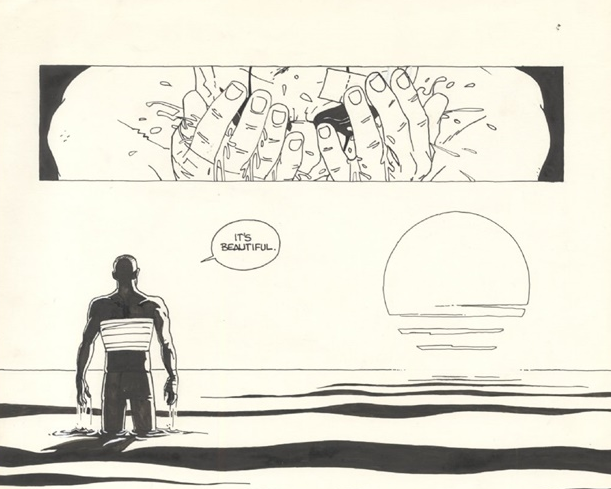 Written by Daisuke Igarashi
Written by Daisuke IgarashiIllustrated by Daisuke Igarashi
Viz
Children of the Sea was Viz's debut manga on the Ikki site they created last year. I have to admit that after reading the first chapter, I was not exactly wowed. The pacing seemed as slow as the drifting glaciers and I didn't see much that would excite me.
However, I don't think you should ever judge a comic by one chapter. (Imagine the impression you'd get of the Fantastic Four if you only looked at the issue where they're battling common crooks from early in the run.) Children of the Sea, like the ocean upon which it is focused, has a lot going on under the surface, making it a good read.
Children of the Sea is the story of Ruka, a young girl who has issues in her regular life. She once saw something strange at an aquarium and feels the need to return to the ocean to escape her problems. This leads her to Umi and Sora, two boys that are more fish than man, even having to keep themselves constantly hydrated.
Turns out that her father knows the boys, and is working with a guy named Jim to discover why these boys exist and how to keep them alive. It allows Ruka to spend time with them, as they seem to share a common bond--that strange thing she saw way back when. As fish keep disappearing and acting in strange ways, Ruka can't help but think its linked to herself and the boys--but how?
That's the mystery that's still to be unveiled, as Sora goes missing and more sea life rises from the ocean floor. By the end of this volume, we're left with more questions than answers and that's the bait that will lure me in to reading future volumes.
This volume of Children of the Sea is slow and methodical, like the waves of the ocean itself. A grown up Ruka introduces the story, giving hints as to where the story will progress. Then we have an overly long section where we learn that Ruka is a bundle of frustrated energy. I'm sure there's a reason for it, but I can't help thinking it could have been shorter.
Once we get to meet Sora, the least human of our trio of characters, things start to pick up. Sora isn't sure he likes Ruka joining the world of Umi and himself, but he goes along with it--if only to show Ruka over and over again how unlike them she is. Around that point, we also get key information on just what Umi and Sora are as well as why the fish are disappearing. Still, Igarashi is very slow to provide any definitive information, preferring to make the reader follow along at his pace.
The story itself looks like it could go some very interesting places. Most who believe in evolution feel that life came out of the sea after something dropped into earth making it capable of holding life. I think there's a definite set of hints, starting with older Ruka's opening narration, that this is going to be a big part of the story. I'll be curious to see where Igarashi takes the reader next and if we will have any science fiction mixed with our fantasy.
Ruka, Umi, and Sora are a good set of main characters. They share the common bond of the sea mystery, but not much else. But that one item is enough to bind them together, as no one else in their world, save perhaps the tatoo-laden Jim, understands the strange nature of the ghosts calling to them. (I say "in their world" because I think this might be happening elsewhere based on a scene towards the end of the book.) In addition, they are like varying degrees of the same person. Ruka is more human than Umi, who is in turn more human than Sora. All three act accordingly, with Umi having the hardest role, that of the person not different enough to fit in either world.
Igarashi is setting things up so that these three look like they hold the key to solving the entire mystery of the lost fish, but can they work together to solve the mystery? Furthermore, as kids with their own emotional issues, will they care enough to try? Only future volumes will give us the answer to this one, and it may take awhile as this is an ongoing series.
One of the things I found most interesting about Children of the Sea is Igarashi's art. He draws intricately detailed fish, right down to their markings, and the aquarium scenes have machines drawn almost down to the last bolt. But his human figures are a bit fuzzy at the edges, often with almost undefined features. Jim's head never looks quite right to me, and I feel sometimes like the people in the story were left two-dimensional while their world has a vibrant depth. I think this is the first manga I've read where I felt the backgrounds were better drawn than the characters.
It's a fascinating design choice that might be a commentary on the story itself or maybe is just an artistic quirk. Either way, it makes the art in Children of the Sea stand out against most manga. I was a bit thrown at first, but soon grew to like the look--it reminded me of reading a small publisher comic with a unique style as opposed to the house style of a major publisher. It made me start to think about all the manga out there that doesn't fit the conventional norms and how we probably only see a fraction of that comic work here in English.
Viz is breaking out of the usual comfort zone with their Signature line, and I'm happy to see that a major English manga publisher is willing to try that. If Children of the Sea is any indication, there's a lot of good manga out there that doesn't happen in a school, on a magical-based battlefield, or in the inner city of Tokyo.
Don't be afraid of Children of the Sea's slow start. Within this manga is a really intriguing story and an innovate art style that's only just starting to get really good by the end of the first volume. I can't wait for volume two to wash up on my shores to continue the story of Ruka and her two mermaid-like companions.
You can sample a bit of Children of the Sea here.







